Quantum Magnetometers: Navigating Human Realms
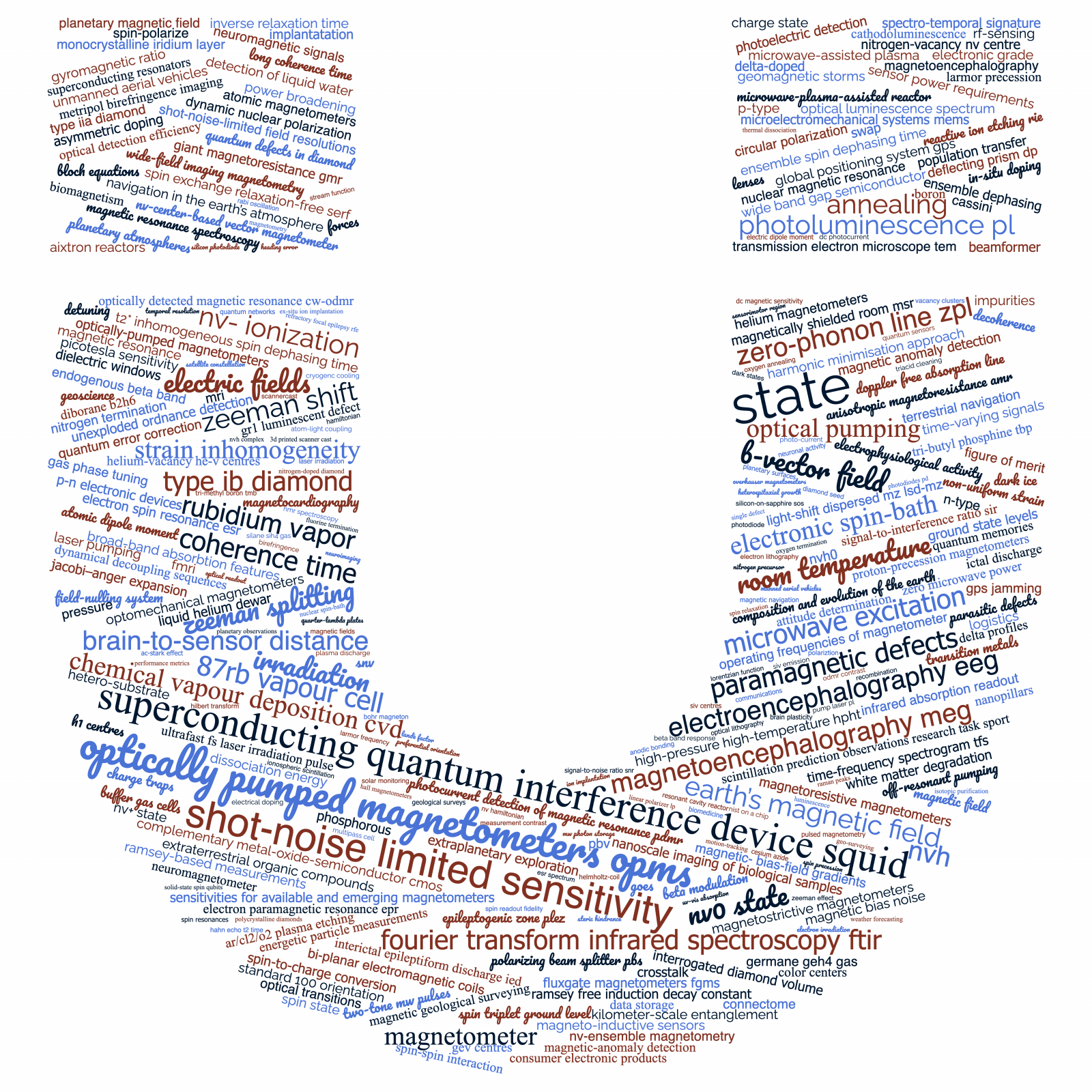
If a quantum technology cannot make our human lives healthier, wealthier, and more enjoyable, then what’s its value? These human-realm, quantum technology use cases: Brains, Civilization, and GPS-Free Travel, probe magnetic fields with greater sensitivities and ease-of-use than before.
The range of the magnetic B-field that we are probing today is 1pT — 1fT. See Fig. 1. The Earth’s magnetic field amplitude (10-4 T) is ~1000 times larger than environmental noise (10-7—10-9 T), and ~100 million times larger than the magnetic fields generated at the scalp by neural currents in magneto-encephalography (MEG)
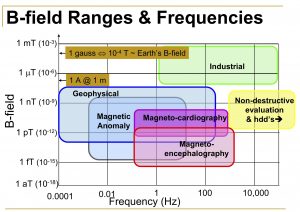
Figure 1. From High Sensitivity Magnetic Field Sensor Technology slide 11, of David Pappas (NIST)’s tutorial at the APS 2008 March Meeting of the American Physical Society meeting.
Bennett et al’s, 2021 Review: Precision Magnetometers for Aerospace Applications in the annotated Fig. 2 shows our area-of-interest. In the red rectangle, we see that sensors are moving to: smaller sizes, more precise resolution, and smaller power requirements. Of particular interest for our use cases, are these four:
- NV = nitrogen vacancy in diamond (see IQT: Quantum Diamond Deficits and Assets);
- AVC = atomic vapor cell: A glass cell holding a 400K vapor of alkali atoms, upon laser illumination, will align its spins. If a magnetic field is present, a polarization or amplitude change in the retransmitted light appears (section 3.1 in Bennett et al’s, 2021);
- SERF = Spin Exchange Relaxation-Free: like AVC, but denser vapor at a higher temperature, which results in a higher sensitivity (section 3.1 in Bennett et al’s, 2021 Review); and
SQUID = superconducting quantum interference devices; robust mid-1960s technology
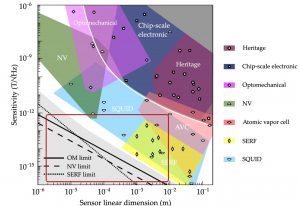
Figure 2. OM= optomechanical, NV = NV centers in diamond, Atomic Vapor Cell + SERF = trapped atom quantum technology, SQUID – SQUID (Superconducting Quantum Interference Device), from Bennett et al’s, 2021 Review: Precision Magnetometers for Aerospace Applications
Regarding OM = Optomechanical: This is a rich topic to be written separately in the future. If you are OM-curious, see section 3.2 in Bennett et al’s, 2021 Review, further details in Li et al., 2021 Cavity Optomechanical Sensing.
Brains
Magneto-encephalography (MEG) is a non-invasive, neurophysiological technique that measures the magnetic fields generated by neuronal activity of the brain. MEG is direct, with higher temporal resolution: ~ms, and higher spatial resolution: ~mm, than indirect measurements, such as fMRI, PET and SPECT.
The gold standard for MEGs is currently SQUID, but that standard began to shift in 2018 to atomic vapor cell quantum (AVC) technology; in particular, to optically-pumped magnetometers (OPMs), with Boto et al, 2018’s new MEG system. While SQUID sensors have femtotesla (fT) sensitivity, the SQUID sensors have some negatives: 1) cryogenic cooling requirements, 2) rigid, patient-head-movement inside of a ~500 kg unit, 3) inflexibility to varying head sizes. For pediatric patients, MEGs by SQUID sensors are especially unsuitable.
Boto et al, 2018’s MEG-OPM prototype system addressed these negatives with a ~1kg custom helmet, where 13 OPM sensors were mounted. Each sensor was a 3x3x3 mm3, 87Rb-vapor-filled and heated component at ~150C, with helmet body temperature. The helmet was a 3D-printed ‘scanner-cast’, designed for the patient’s head, using an anatomical MRI scan. The magnetic field was indicated by a photodiode-detectable drop in light transmission, after a 795 nm, circularly polarized laser beam, spin-polarized the cell’s Rb atoms.
Feys et al, May 2022 work: On-Scalp Optically Pumped Magnetometers versus Cryogenic Magnetoencephalography for Diagnostic Evaluation of Epilepsy in School-aged Children improves upon the above with 32 sensors, tested with pediatric patients, who have idiopathic or refractory focal epilepsy. The research goal was to detect interictal epileptic discharges (IEDs) and compare the MEG-OPM data with MEG-SQUID data. Feys et al, 2022’s work demonstrated that MEG-OPM provided similar sensitivity: 1-3pT/Hz1/2, but higher IED amplitude and higher signal-to-noise than conventional MEG-SQUIDs. Figure 3 indicates the experimental set up.
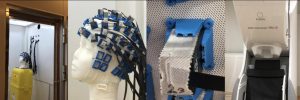
Figure 3 Experimental Setup for MEG IED measurement of OPM versus SQUID (4th figure) from Feys et al, 2022.
The MEG research field is active with new approaches implementing flexible OPM and SERF designs. A glimpse of what is ahead can be seen in the use cases of the Abstract book of the Today’s Noise Tomorrow’s Signal 2019 workshop.
Civilizations
The gold standard for archeological magnetic field mapping is also SQUID technology. A high-profile example, which discovered the historical extent of the capital: Karakorum of the Mongol Era, was published by Bemmann et al, 2021, last November, with a lead in Nature. The journal displayed an exotic-looking field photo, which included a wagon carrying a set of cryonically cooled SQUIDs that was pulled by an off-road vehicle. Why would Nature highlight a science result based on SQUID, which is mid-1960s technology? Intrigue won the day.
I suggest to archeological magnetic mappers to consider the benefits of the geophysics approach to use drones. With a keyword search: UAV magnetic field mapping, you will discover drone-mounted, magnetometers, based on atomic vapor cells that approximate the magnetic field flux sensitivity of SQUID sensors: on the order of several pT/Hz1/2. In addition, new operational modes for atomic vapor cells, such as light-shift-dispersed Mz, have been developed, that would further increase the magnetometer’s sensitivity.
Consider these advantages:
1) More efficient data collection and processing, 2) lower field cost, 3) access to inaccessible or high risk regions, 4) greater worker safety, 5) UAV integration with other geophysical sensors, and 6) no need for cryostats. A disadvantage compared to SQUID is the scalar, instead of vector, magnetic flux measurement. However, GPS inertial sensors and a high sampling rate can provide mapping capabilities. This 21-minute video from Geometrics, from which I grabbed a frame for Fig. 4, demonstrates such a system in the field.
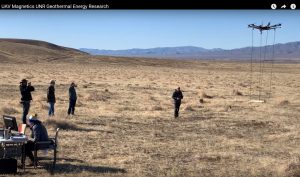
Figure 4 A frame-grab from a Geometrics video, which demonstrates UAV magnetic-field mapping
GPS-free Travel
Where is Dark Ice? We begin this section with a mystery. Lockheed Martin put significant resources into developing the NV in diamond magnetometer prototype, with a team (led by M.J. DiMario), an Element-6 partnership for diamond manufacture, 21 patents, Dark Ice tests and future plans, public press (which led to hundreds of international press pieces), Dark Ice trademark and a logo applications, a research preprint (Edmonds et al, 2020) and publication (Edmonds, et al, 2021).
Yet Lockheed Martin never followed up its logo application request, and the company never provided a trademark “statement of use” (SOU) to the USPTO. Therefore the logo and trademark were dropped (many thanks to D. Barnes to understand the legalities). The Dark Ice team leader left Lockheed Martin in 2020, to form his own company. Of the public research results, in Figure 1 of the preprint, the instrument is only called ‘Device’, and in the corresponding 2021 journal article, the photo of Dark Ice’s hardware is deleted altogether. Dark Ice appears to have gone ‘Dark’.
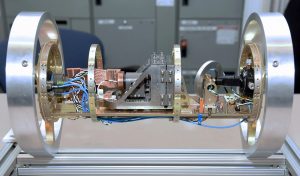
Figure 5 Lockheed Martin’s 2019 press release photo of the Dark Ice device
The prototype used a synthetic nitrogen-doped diamond to measure the magnetic field variations: strength and direction. When overlaid with maps of Earth’s magnetic field, supplied by the National Oceanic and Atmospheric Association, the prototype produced Earth location information. This technology would potentially support situations when GPS was not available or in otherwise challenging conditions. According to the Dark Ice team’s preprint and published papers, the diamond’s chemical vapor deposition (CVD) manufacturing process was successful to probe irradiation and annealing procedures to support the manufacture of quantum-tech quality NV diamonds.
Today, the development focus in the NV in diamond research field is to improve the manufacture of such diamonds and to improve readout fidelity technologies.
As described in the comprehensive Achard et al, 2020 Review: CVD diamond single crystals with NV centres, the main advantages of CVD for making quantum-grade diamonds is the ability to engineer stacked layers of different doping and composition in a dynamic and very flexible way that can scale. The Review presents the best processes dependent on application, including for magnetometry. The ∼10-15 ppm, quantum-tech regime, implemented by the Dark Ice team, requires adapted growth conditions that allow for high doping efficiency, while preserving the crystalline quality. The Edmonds et al, 2021 results further identified the limiting sensitivity factors for a magnetometer. Himadri Chatterjee’s 2021 PhD thesis used an Element-6/Dark Ice-process diamond with other diamond samples and demonstrated magnetic field detection sensitivities into the ~100 nT/Hz1/2 regime, using IR absorption magnetometry. He provided a list of improvements for the system’s sensitivity to reach the tens of pT/Hz1/2 sensitivity of other researchers. His thesis and the Achard et al Review are good sources to find descriptions of the community’s research efforts.
While Dark Ice’s disappearance might be concerning news about the technical viability of such magnetometers, don’t worry. This note should reassure you that NV in diamond magnetometer progress marches on.
Amara Graps, Ph.D. is an interdisciplinary physicist, planetary scientist, science communicator and educator and expert on all quantum technologies.



















